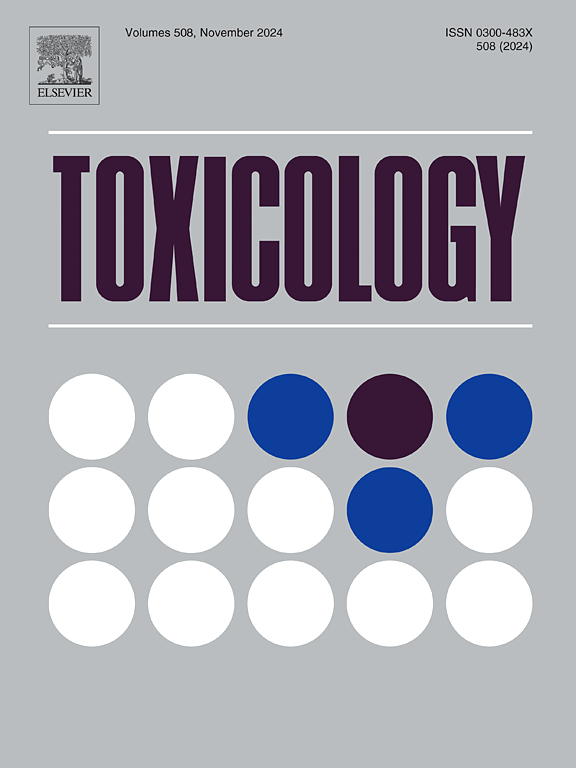聚乙烯微塑料破坏局灶黏附激酶(FAK)信号和支持细胞代谢,损害血睾丸屏障功能和精子发生。
IF 4.6
3区 医学
Q1 PHARMACOLOGY & PHARMACY
引用次数: 0
摘要
聚乙烯微塑料(PE-MPs)广泛用于个人护理应用,是一种不可生物降解的污染物,具有生物积累潜力和毒理学相关性。最近的研究在人类精液和睾丸组织中发现了微塑料,这引起了人们对其对男性生殖健康影响的担忧。本研究研究了口服20µg/mL、200µg/mL和2000 µg/mL剂量的聚乙烯微塑料(PE-MPs)对大鼠56天的毒理学影响,重点研究了血睾丸屏障(BTB)的破坏和外质特化(ES)的破坏,这两种物质对正常精子发生都是必不可少的。Western blot分析显示,pe - mps处理大鼠的btb相关紧密连接蛋白occludin、cludin -11、N-cadherin、E-cadherin和衔接蛋白ZO-1以及类固醇生成标记物StAR明显减少,表明屏障完整性和类固醇生成功能被破坏。PE-MPs暴露可显著降低p-FAK (Tyr407),损害F-actin组织,导致开放性BTB。同时,p-FAK (Tyr397)表达增加导致精细胞粘附降低,破坏顶端ES动力学,导致漏性BTB通透性增加。这些改变导致精子受精失败、生殖细胞过早脱落和精子发生受损。此外,我们还探讨了Akt和哺乳动物雷帕霉素(mTOR)的表达靶点,以了解它们在pe - mps诱导的睾丸毒性中的潜在作用。暴露于PE-MPs显著改变了17种血清代谢物,表明通过¹H NMR代谢组学鉴定的代谢紊乱。高剂量PE-MPs显著提高大鼠血清丙酮酸和乳酸水平,可能由于BTB的破坏而浸润睾丸。此外,PE-MPs暴露显著提高了血清组氨酸与酪氨酸的比例,表明氨基酸代谢受到破坏。这些研究结果表明,PE-MPs损害BTB完整性,破坏ES动力学,损害精子发生,并诱导全身代谢改变,突出了它们对男性生殖健康的潜在风险。本文章由计算机程序翻译,如有差异,请以英文原文为准。
Polyethylene microplastics disrupt focal adhesion kinase (FAK) signaling and sertoli cell metabolism, compromising blood-testis barrier function and spermatogenesis
Polyethylene microplastics (PE-MPs), used extensively in personal care applications, are non-biodegradable pollutants with demonstrated bioaccumulation potential and toxicological relevance. Recent studies have detected microplastics in human semen and testicular tissues, raising concerns about their effect on male reproductive health. This study investigates the toxicological effects of orally administered polyethylene microplastics (PE-MPs) at 20 µg/mL, 200 µg/mL, and 2000 µg/mL doses in rats for 56 days, with a focus on disruption of the blood-testis barrier (BTB) and destabilization of ectoplasmic specialization (ES), both essential for normal spermatogenesis. Western blot analysis showed a marked reduction in BTB-associated tight junction proteins occludin, claudin-11, N-cadherin, E-cadherin, and adaptor protein ZO-1, as well as the steroidogenic marker StAR in PE-MPs-treated rats, indicating disruption of barrier integrity and steroidogenic function. PE-MPs exposure significantly reduced p-FAK (Tyr407), could impair the F-actin organization, and lead to an open BTB. At the same time, increased p-FAK (Tyr397) expression resulted in decreased spermatid adhesion, disrupting apical ES dynamics and contributing to a leaky BTB with increased permeability. These alterations led to spermiation failure, premature germ cell exfoliation, and impaired spermatogenesis. Additionally, the Akt and mammalian rapamycin (mTOR) expression targets were explored to understand their potential role in PE-MPs-induced testicular toxicity. The exposure to PE-MPs significantly altered 17 serum metabolites, indicating metabolic disturbances identified through ¹H NMR metabolomics. High doses of PE-MPs significantly elevated serum pyruvate and lactate levels in rats, possibly infiltrating the testis due to disruption of the BTB. Also, PE-MPs exposure significantly elevated the serum histidine-to-tyrosine ratio, indicating disrupted amino acid metabolism. These findings demonstrate that PE-MPs compromise BTB integrity, disrupt ES dynamics, impair spermatogenesis, and induce systemic metabolic alterations, highlighting their potential risk to male reproductive health.
求助全文
通过发布文献求助,成功后即可免费获取论文全文。
去求助
来源期刊

Toxicology
医学-毒理学
CiteScore
7.80
自引率
4.40%
发文量
222
审稿时长
23 days
期刊介绍:
Toxicology is an international, peer-reviewed journal that publishes only the highest quality original scientific research and critical reviews describing hypothesis-based investigations into mechanisms of toxicity associated with exposures to xenobiotic chemicals, particularly as it relates to human health. In this respect "mechanisms" is defined on both the macro (e.g. physiological, biological, kinetic, species, sex, etc.) and molecular (genomic, transcriptomic, metabolic, etc.) scale. Emphasis is placed on findings that identify novel hazards and that can be extrapolated to exposures and mechanisms that are relevant to estimating human risk. Toxicology also publishes brief communications, personal commentaries and opinion articles, as well as concise expert reviews on contemporary topics. All research and review articles published in Toxicology are subject to rigorous peer review. Authors are asked to contact the Editor-in-Chief prior to submitting review articles or commentaries for consideration for publication in Toxicology.
 求助内容:
求助内容: 应助结果提醒方式:
应助结果提醒方式:


